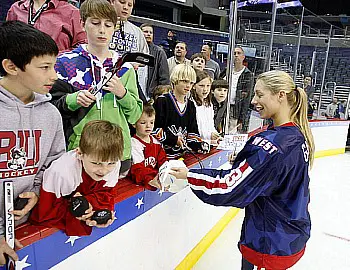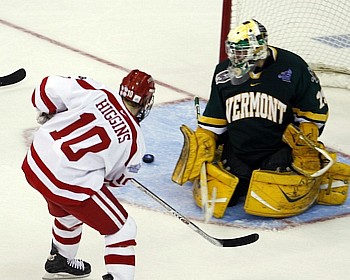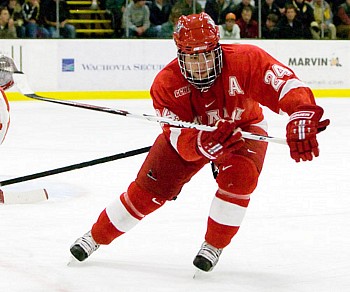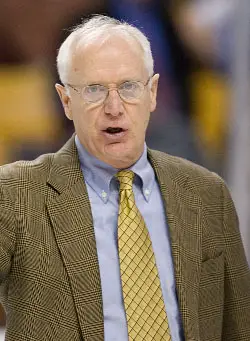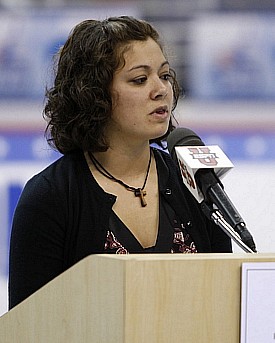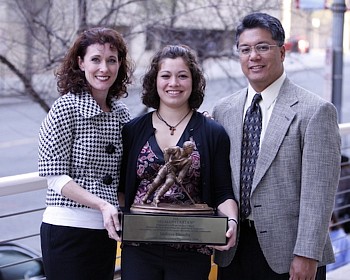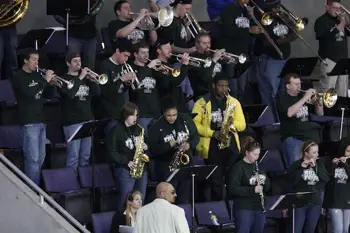A few years back, someone asked Hockey East Commissioner Joe Bertagna if he was concerned that no Hockey East teams were in the Frozen Four that season.
He replied simply that these things go in cycles.
This season, Hockey East has the defending national champion in Boston College. The Eagles will be dethroned Saturday, but another Hockey East team may take the title in the form of Boston University.
Toss in the honor of having a clean sweep of the Hobey “Hat Trick” finalists, of course including the winner, Matt Gilroy of BU, and you have a pretty special year for the conference from New England.
“I remember when they were asking us if it was the end of the world that we couldn’t win a national title or didn’t have teams that got this far,” joked Bertagna. “We are really proud of our two Frozen Four teams and equally proud of Brad Thiessen, Colin Wilson, and Matt Gilroy as the final three candidates for the Hobey Baker Award.”
Bertagna warned about being overly optimistic.
“Like I said, these things go in cycles so we’re not getting too giddy. Every conference has elite players and elite programs.”
While Bertagna’s pride in Hockey East is evident, it is his work with the American Hockey Coaches Association that also shows how important Bertagna is to college hockey.
The association (www.ahcahockey.com), which has been around since 1947, has been working tirelessly to improve not only college hockey but hockey across the United States.
The AHCA was formed in May of 1947 in Boston by a handful of college coaches concerned about the game they loved. It has grown to include professional, junior, high school, and youth hockey coaches as well as referees, administrators, sales representatives, journalists, and fans.
The objectives of the ACHA, as spelled out in its constitution, are the following:
1. To help maintain the highest possible standards in hockey and the hockey profession.
2. To discuss matters of mutual interest.
3. To submit to the proper organizations, suggestions for the improvement of hockey.
4. To discuss various phases of hockey.
5. To place at the disposal of coaches sources of hockey information.
6. To work together for the improvement of conditions in American hockey.
7. To have a representative group of hockey people before whom hockey problems of general interest may be discussed and to whom others may be referred for the friendly interchange of ideas.
8. To establish good fellowship and social contact.
9. To maintain high educational standards when coaching the game of ice hockey.
Bertagna splits duties with Bruce Delventhal, the athletics director at Plattsburgh State, and they are the two who “steer the ship.” The need for a full-time director came about in the early 1990s as the workload for the coaches who ran the association got too great for their busy schedules.
Enter Bertagna, who gladly accepted the volunteer position in conjunction with duties running Hockey East.
The goal of the association was to grow past its interests in college hockey (though make no mistake, that is a major priority) to include hockey coaches, administrators, and those who play support roles at all levels of hockey. That includes the vendors who have a prominent role at the trade show during the national convention in Naples, Fla., every year at the end of April.
The association has grown by leaps and bounds in recent years and has done so by making it affordable for entire coaching staffs to join for a certain price, or by making individual memberships available at an affordable price.
Another great move by the AHCA was including the American College Hockey Association a “partner” in the association. The ACHA is the governing body for club hockey in the U.S. and their ability to share time, space and recognition with the NCAA’s varsity programs has helped raise their profile and level of play.
“The other place we are looking to continually improve is with our connection to junior hockey,” said Bertagna. “The United States Hockey League (Tier I Junior A) and the Eastern Junior Hockey League (Tier III Junior A) have a membership program available to their coaches at an affordable price.
“We also have made a major effort to connect with high-school coaches across the country. It’s an ongoing effort.”
A look at the website shows the advantages of membership. Access to Q and A’s with elite-level NCAA coaches, access to drills used by NCAA coaches and the association newsletter filled with helpful information to coaches at any level is included.
Most importantly, especially for coaches who are preparing players for college hockey, the AHCA Directory has the address of every varsity and club program in the nation.
“The impression that club hockey is a midnight van to the rink with a case of beer in it is the wrong impression to have,” said Bertagna. “Club hockey and the ACHA have done very well and have a good level of play at some really good schools. Penn State has a D-I club team that has been very successful.”
Bertagna said one of the goals of the association for non-NCA coaches is not only to improve their access to coaches who can help them improve, but to also get the message across to them about being honest with their players about their college chances.
There are ample chances to play college hockey, but whether it be at the Division I level at Michigan State, the D-III level at Plattsburgh State or the club level at Penn State, the key is being able to evaluate and guide your players to the proper place to play.
The Association continues to make strides to being more accessible to coaches who can’t get to the Frozen Four or to the convention in Naples. With USA Hockey, which Bertagna described as a great partner, the word has gotten around about the AHCA via the USA Hockey Coaching Education program.
That program, which is well-run out of Colorado Springs by Mark Tabrum, has assisted the AHCA by including its literature at the various certification seminars across the country.
“It is an ongoing process to make the AHCA better but look at the level of coaches we have running it. It is a credit to them that we have been so successful.”
